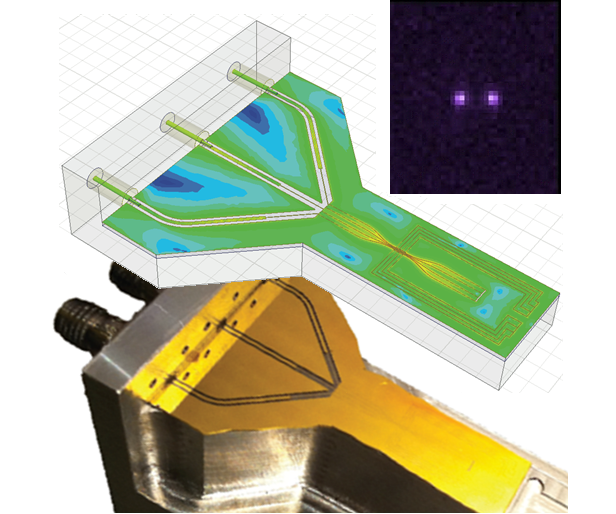NQIT researchers push electronic control of qubits to new levels of precision
In recent work reported in Physical Review Letters [1], Dr Tom Harty, Martin Sepiol and colleagues, report the achievement of a two-qubit entangling gate – the fundamental operation of quantum logic – driven by electronic microwave signals instead of by laser beams. The precision of the gate improves on previous microwave work by nearly two orders of magnitude, and approaches the levels required for a quantum computer.
Microwave quantum logic methods such as this may substantially simplify the formidable engineering challenge of building a practical quantum computer, by replacing some of the complex laser systems generally used to manipulate trapped-ion qubits by off-the-shelf electronic components similar to those used in, for example, smartphone technology.
Microwave techniques are used in several candidate qubit platforms, but ion traps are one of the few technologies that operate sufficiently well at room temperature. Moreover, as trapped-ion qubits respond to both microwave and optical signals, the methods are still compatible with NQIT’s photonically-linked network architecture. Microwave-driven quantum logic gates were first demonstrated at NIST in Boulder, U.S.A. [2] and at the University of Siegen in Germany [3], though with a precision well below that required for quantum computing applications.
In the recent publication, the NQIT researchers introduce a new “dynamically decoupled” microwave gate mechanism, and use it to achieve an entangling operation with 99.7% precision. This is close to the world state-of-the-art achieved with laser beams demonstrated by NQIT and NIST earlier this year. The microwave gate was performed in the same device that was previously used to demonstrate the longest-lived single-qubit memory and the highest precision single-qubit manipulation [4].
This result demonstrates for the first time that electronically-driven quantum gates for trapped-ion qubits are capable of a precision comparable with the state-of-the-art achieved with lasers, or in other qubit platforms.
References:
[1] "High-Fidelity Trapped-Ion Quantum Logic Using Near-Field Microwaves" T.P.Harty, M.A.Sepiol et al., Phys.Rev.Lett., 117, 140501, September 2016.
[2] "Microwave quantum logic gates for trapped ions" C.Ospelkaus, U.Warring et al., Nature 476, 181, August 2011.
[3] "Designer Spin Pseudomolecule Implemented with Trapped Ions in a Magnetic Gradient" A.Khromova, C.Piltz et al., Phys.Rev.Lett. 108, 220502, June 2012.
[4] "High-Fidelity Preparation, Gates, Memory, and Readout of a Trapped-Ion Quantum Bit" T.P.Harty, D.T.C.Allcock et al., Phys.Rev.Lett. 113, 220501, November 2014.
Find out more about NQIT's work on microwave ion trap technology:
